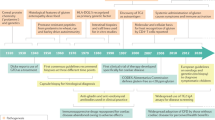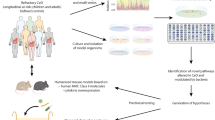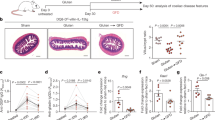Abstract
Gene therapy (GT) is still at the ‘experimental’ stage and some recent setbacks have cooled the potential use of this therapeutic tool even in life-threatening conditions. However, this therapeutic approach has a potential, which is not limited to disease for which we have not other option. There are increasing evidence that GT will be soon used in diseases that are not life threatening. One group of diseases that can benefit from GT is the autoimmune one. Several experimental animal models have indicated the efficacy (proof of principle) of GT. In the present review, we have addressed the possibility that even extremely benign autoimmune-like diseases such as Celiac Disease (CD) might one day profit from this type of therapy. We further point that in conditions such as CD, where the trigger is well known and the pathogenic cascade is relatively well defined, a situation not common in autoimmunity, we can even have a better situation where to explore and use GT to control disease initiation and progression. Once the risks that are still intrinsic to GT will have been reduced the therapeutic options we outline in the present review might not appear too far from reality.
This is a preview of subscription content, access via your institution
Access options
Subscribe to this journal
Receive 12 print issues and online access
$259.00 per year
only $21.58 per issue
Buy this article
- Purchase on Springer Link
- Instant access to full article PDF
Prices may be subject to local taxes which are calculated during checkout




Similar content being viewed by others
References
Somia N, Verma IM . Gene therapy: trials and tribulations. Nat Rev Genet 2000; 1: 91–99.
Verma IM, Somia N . Gene therapy – promises, problems and prospects. Nature 1997; 389: 239–242.
Griesenbach U, Ferrari S, Geddes DM, Alton EW . Gene therapy progress and prospects: cystic fibrosis. Gene Ther 2002; 9: 1344–1350.
Fischer A, Hacein-Bey S, Cavazzana-Calvo M . Gene therapy of severe combined immunodeficiencies. Nat Rev Immunol 2002; 2: 615–621.
Kessels HW, Wolkers MC, van dB, van der Valk MA, Schumacher TN . Immunotherapy through TCR gene transfer. Nat Immunol 2001; 2: 957–961.
Thomas ED . The Nobel Lectures in Immunology. The Nobel Prize for Physiology or Medicine, 1990. Bone marrow transplantation – past, present and future. Scand J Immunol 1994; 39: 339–345.
Viganego F, Nash R, Furst DE . Bone marrow transplantation in the treatment of systemic sclerosis. Curr Rheumatol Rep 2000; 2: 492–500.
Mandalfino P et al. Bone marrow transplantation in multiple sclerosis. J Neurol 2000; 247: 691–695.
Brodsky RA, Smith BD . Bone marrow transplantation for autoimmune diseases. Curr Opin Oncol 1999; 11: 83–86.
Chernajovsky Y, Adams G, Triantaphyllopoulos K, Ledda MF, Podhajcer OL . Pathogenic lymphoid cells engineered to express TGF beta 1 ameliorate disease in a collagen-induced arthritis model. Gene Ther 1997; 4: 553–559.
Nakajima A et al. Antigen-specific T cell-mediated gene therapy in collagen-induced arthritis. J Clin Invest 2001; 107: 1293–1301.
Shaw MK et al. Local delivery of interleukin 4 by retrovirus-transduced T lymphocytes ameliorates experimental autoimmune encephalomyelitis. J Exp Med 1997; 185: 1711–1714.
Morita Y et al. Dendritic cells genetically engineered to express IL-4 inhibit murine collagen-induced arthritis. J Clin Invest 2001; 107: 1275–1284.
Zhang HG et al. Induction of specific T cell tolerance by Fas ligand-expressing antigen-presenting cells. J Immunol 1999; 162: 1423–1430.
Tomita T et al. Suppressed severity of collagen-induced arthritis by in vivo transfection of nuclear factor kappaB decoy oligodeoxynucleotides as a gene therapy. Arthritis Rheum 1999; 42: 2532–2542.
Zhang HG et al. Gene therapy that inhibits nuclear translocation of nuclear factor kappaB results in tumor necrosis factor alpha-induced apoptosis of human synovial fibroblasts. Arthritis Rheum 2000; 43: 1094–1105.
Maki M, Collin P . Coeliac disease. Lancet 1997; 349: 1755–1759.
Fasano A, Catassi C . Current approaches to diagnosis and treatment of celiac disease: an evolving spectrum. Gastroenterology 2001; 120: 636–651.
Loftus CG, Loftus Jr EV . Cancer risk in celiac disease. Gastroenterology 2002; 123: 1726–1729.
Sollid LM . Molecular basis of celiac disease. Annu Rev Immunol 2000; 18: 53–81.
Maiuri L et al. Definition of the initial immunologic modifications upon in vitro gliadin challenge in the small intestine of celiac patients. Gastroenterology 1996; 110: 1368–1378.
Maiuri L et al. Blockage of T-cell costimulation inhibits T-cell action in celiac disease. Gastroenterology 1998; 115: 564–572.
Korponay-Szabo IR et al. Missing endomysial and reticulin binding of coeliac antibodies in transglutaminase 2 knockout tissues. Gut 2003; 52: 199–204.
Maki M, Hallstrom O, Marttinen A . Reaction of human non-collagenous polypeptides with coeliac disease autoantibodies. Lancet 1991; 338: 724–725.
Maki M, Huupponen T, Holm K, Hallstrom O . Seroconversion of reticulin autoantibodies predicts coeliac disease in insulin dependent diabetes mellitus. Gut 1995; 36: 239–242.
Amara W, Husebekk A . Improved method for serological testing in celiac disease – IgA anti-endomysium antibody test: a comparison between monkey oesophagus and human umbilical cord as substrate in indirect immunofluorescence test. Scand J Clin Lab Invest 1998; 58: 547–554.
Dieterich W et al. Identification of tissue transglutaminase as the autoantigen of celiac disease. Nat Med 1997; 3: 797–801.
Dieterich W et al. Autoantibodies to tissue transglutaminase as predictors of celiac disease. Gastroenterology 1998; 115: 1317–1321.
Sulkanen S et al. Tissue transglutaminase autoantibody enzyme-linked immunosorbent assay in detecting celiac disease. Gastroenterology 1998; 115: 1322–1328.
Molberg O et al. Tissue transglutaminase selectively modifies gliadin peptides that are recognized by gut-derived T cells in celiac disease. Nat Med 1998; 4: 713–717.
van de WY et al. Selective deamidation by tissue transglutaminase strongly enhances gliadin-specific T cell reactivity. J Immunol 1998; 161: 1585–1588.
Quaratino S, Feldmann M, Dayan CM, Acuto O, Londei M . Human self-reactive T cell clones expressing identical T cell receptor beta chains differ in their ability to recognize a cryptic self-epitope. J Exp Med 1996; 183: 349–358.
Michaelsson E et al. T cell recognition of carbohydrates on type II collagen. J Exp Med 1994; 180: 745–749.
Manoury B et al. Destructive processing by asparagine endopeptidase limits presentation of a dominant T cell epitope in MBP. Nat Immunol 2002; 3: 169–174.
Anderton SM, Viner NJ, Matharu P, Lowrey PA, Wraith DC . Influence of a dominant cryptic epitope on autoimmune T cell tolerance. Nat Immunol (2002).
Shan L et al. Structural basis for gluten intolerance in celiac sprue. Science 2002; 297: 2275–2279.
Arentz-Hansen H et al. The intestinal T cell response to alpha-gliadin in adult celiac disease is focused on a single deamidated glutamine targeted by tissue transglutaminase. J Exp Med 2000; 191: 603–612.
Kutlu T et al. Numbers of T cell receptor (TCR) alpha beta+ but not of TcR gamma delta+ intraepithelial lymphocytes correlate with the grade of villous atrophy in coeliac patients on a long term normal diet. Gut 1993; 34: 208–214.
Jabri B et al. Selective expansion of intraepithelial lymphocytes expressing the HLA-E-specific natural killer receptor CD94 in celiac disease. Gastroenterology 2000; 118: 867–879.
Maiuri L et al. IL-15 drives the specific migration of CD94+ and TCR-gamma delta+ intraepithelial lymphocytes in organ cultures of treated celiac patients. Am J Gastroenterol 2001; 96: 150–156.
Maiuri L et al. FAS engagement drives apoptosis of enterocytes of coeliac patients. Gut 2001; 48: 418–424.
Ciccocioppo R et al. Mechanisms of villous atrophy in autoimmune enteropathy and coeliac disease. Clin Exp Immunol 2002; 128: 88–93.
Bauer S et al. Activation of NK cells and T cells by NKG2D, a receptor for stress-inducible MICA. Science 1999; 285: 727–729.
Maiuri L et al. Interleukin 15 mediates epithelial changes in celiac disease. Gastroenterology 2000; 119: 996–1006.
Forsberg G et al. Paradoxical coexpression of proinflammatory and down-regulatory cytokines in intestinal T cells in childhood celiac disease. Gastroenterology 2002; 123: 667–678.
Przemioslo RT et al. Histological changes in small bowel mucosa induced by gliadin sensitive T lymphocytes can be blocked by anti-interferon gamma antibody. Gut 1995; 36: 874–879.
Nilsen EM et al. Gluten induces an intestinal cytokine response strongly dominated by interferon gamma in patients with celiac disease. Gastroenterology 1998; 115: 551–563.
Fehniger TA, Caligiuri MA . Interleukin 15: biology and relevance to human disease. Blood 2001; 97: 14–32.
Bu P et al. Apoptosis: one of the mechanisms that maintains unresponsiveness of the intestinal mucosal immune system. J Immunol 2001; 166: 6399–6403.
Waldmann TA, Dubois S, Tagaya Y . Contrasting roles of IL-2 and IL-15 in the life and death of lymphocytes: implications for immunotherapy. Immunity 2001; 14: 105–110.
Ruchatz H et al. Soluble IL-15 receptor alpha-chain administration prevents murine collagen-induced arthritis: a role for IL-15 in development of antigen-induced immunopathology. J Immunol 1998; 160: 5654–5660.
Cellier C et al. Refractory sprue, coeliac disease, and enteropathy-associated T-cell lymphoma. French Coeliac Disease Study Group. Lancet 2000; 356: 203–208.
Corrao G et al. Mortality in patients with coeliac disease and their relatives: a cohort study. Lancet 2001; 358: 356–361.
Rabinovich GA et al. Recombinant galectin-1 and its genetic delivery suppress collagen-induced arthritis via T cell apoptosis. J Exp Med 1999; 190: 385–398.
Annenkov A, Chernajovsky Y . Engineering mouse T lymphocytes specific to type II collagen by transduction with a chimeric receptor consisting of a single chain Fv and TCR zeta. Gene Ther 2000; 7: 714–722.
Berlin C et al. Alpha 4 beta 7 integrin mediates lymphocyte binding to the mucosal vascular addressin MAdCAM-1. Cell 1993; 74: 185.
Briskin M et al. Human mucosal addressin cell adhesion molecule-1 is preferentially expressed in intestinal tract and associated lymphoid tissue. Am J Pathol 1997; 151: 97–110.
Barbara G et al. Interleukin 10 gene transfer prevents experimental colitis in rats. Gut 2000; 46: 344–349.
Wirtz S, Galle PR, Neurath MF . Efficient gene delivery to the inflamed colon by local administration of recombinant adenoviruses with normal or modified fibre structure. Gut 1999; 44: 800–807.
Steidler L et al. Treatment of murine colitis by Lactococcus lactis secreting interleukin-10. Science 2000; 289: 1352–1355.
Van Montfrans C et al. Prevention of colitis by interleukin 10-transduced T lymphocytes in the SCID mice transfer model. Gastroenterology 2002; 123: 1865–1876.
Pollok KE et al. Costimulation of transduced T lymphocytes via T cell receptor-CD3 complex and CD28 leads to increased transcription of integrated retrovirus. Hum Gene Ther 1999; 10: 2221–2236.
Van Montfrans C et al. Generation of regulatory gut-homing human T lymphocytes using ex vivo interleukin 10 gene transfer. Gastroenterology 2002; 123: 1877–1888.
Halene S et al. Improved expression in hematopoietic and lymphoid cells in mice after transplantation of bone marrow transduced with a modified retroviral vector. Blood 1999; 94: 3349–3357.
Blaese RM et al. T lymphocyte-directed gene therapy for ADA- SCID: initial trial results after 4 years. Science 1995; 270: 475–480.
Bonini C et al. HSV-TK gene transfer into donor lymphocytes for control of allogeneic graft-versus-leukemia. Science 1997; 276: 1719–1724.
Halttunen T, Maki M . Serum immunoglobulin A from patients with celiac disease inhibits human T84 intestinal crypt epithelial cell differentiation. Gastroenterology 1999; 116: 566–572.
Dubois S et al. Natural splicing of exon 2 of human interleukin-15 receptor alpha-chain mRNA results in a shortened form with a distinct pattern of expression. J Biol Chem 1999; 274: 26978–26984.
Wei X et al. The Sushi domain of soluble IL-15 receptor alpha is essential for binding IL-15 and inhibiting inflammatory and allogenic responses in vitro and in vivo. J Immunol 2001; 167: 277–282.
Dubois S, Mariner J, Waldmann TA, Tagaya Y . IL-15Ralpha recycles and presents IL-15 In trans to neighboring cells. Immunity 2002; 17: 537–547.
Acknowledgements
The present study has been supported by European Community Grant QLK1-CT-1999-00037 and Arthritis Research Campaign, UK.
Author information
Authors and Affiliations
Corresponding author
Rights and permissions
About this article
Cite this article
Londei, M., Quaratino, S. & Maiuri, L. Celiac Disease: a model autoimmune disease with gene therapy applications. Gene Ther 10, 835–843 (2003). https://doi.org/10.1038/sj.gt.3302041
Published:
Issue Date:
DOI: https://doi.org/10.1038/sj.gt.3302041
This article is cited by
-
Gene Delivery to Intestinal Epithelial Cells In vitro and In vivo with Recombinant Adeno-Associated Virus Types 1, 2 and 5
Digestive Diseases and Sciences (2008)



